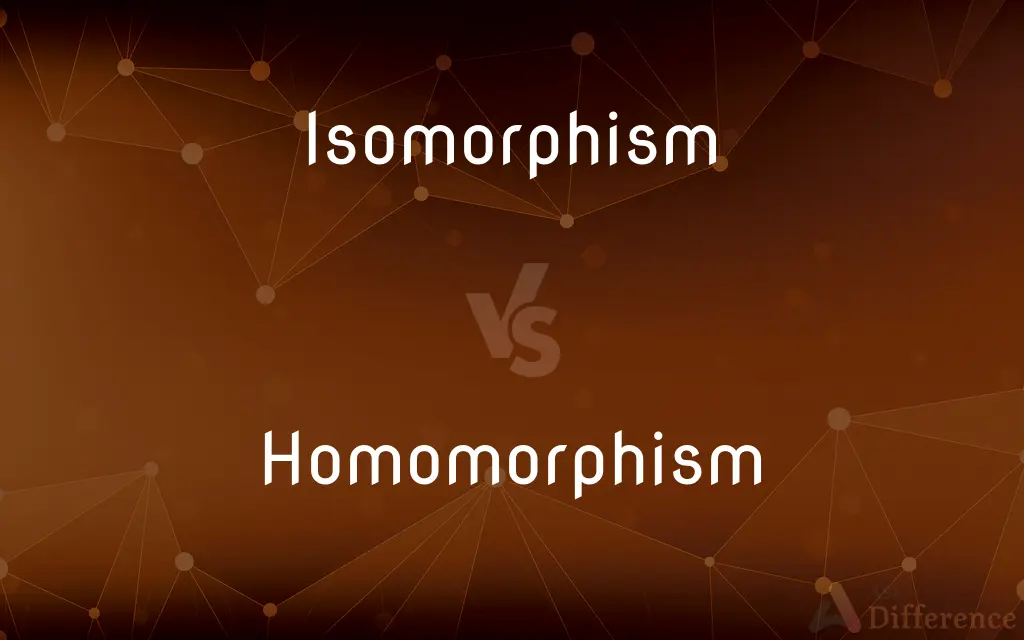Isomorphism vs. Homomorphism — What's the Difference?
By Maham Liaqat & Fiza Rafique — Updated on April 21, 2024
Isomorphism refers to a bijective structure-preserving map between two algebraic structures, ensuring structural equivalence; homomorphism is a more general map that preserves operations but may not be bijective.

Difference Between Isomorphism and Homomorphism
Table of Contents
ADVERTISEMENT
Key Differences
Isomorphism involves a bijective (one-to-one and onto) mapping between two algebraic structures, such as groups, rings, or fields, preserving both structure and operations. Whereas homomorphism includes mappings that preserve algebraic operations but are not necessarily bijective, allowing for a broader range of transformations.
Isomorphic structures are fundamentally the same under different names or notations, highlighting a deeper equivalence in their operations and elements. On the other hand, homomorphic structures may share some operational similarities but differ significantly in their structure or element properties.
Every isomorphism is a homomorphism because it preserves algebraic operations in a bijective manner. On the other hand, not every homomorphism is an isomorphism, as homomorphisms do not require the map to be bijective.
Isomorphisms allow for an exact correspondence between elements and operations of two structures, indicating that one can substitute one structure for the other without loss of information. Whereas homomorphisms may result in loss of information, as they can map multiple distinct elements to a single element.
The concept of isomorphism is crucial in determining the equivalence of categories in mathematics, such as sets, spaces, or groups. In contrast, homomorphisms are essential for understanding structural similarities and the potential embedding of one structure within another.
ADVERTISEMENT
Comparison Chart
Bijectivity
Bijective (one-to-one and onto)
Not necessarily bijective
Preservation
Preserves structure and operations
Preserves operations only
Structural Impact
Structures are equivalent
Structures may not be equivalent
Mapping Type
Always a homomorphism
Subset of general mappings in algebra
Example Structures
Groups, rings, fields
Groups, rings, fields, vector spaces
Compare with Definitions
Isomorphism
Critical for classifying mathematical structures.
Isomorphism in vector spaces involves linear bijective maps preserving vector addition and scalar multiplication.
Homomorphism
Can lead to new algebraic constructs like kernel and image.
The kernel of a group homomorphism is a normal subgroup of the original group.
Isomorphism
Often used in mathematics to signify the perfect correspondence between sets, groups, or fields.
The groups Z/6Z and S3 are not isomorphic, despite both having six elements.
Homomorphism
Used to determine structural similarities and embeddings.
A homomorphism from a group G to itself, known as an endomorphism, can reveal much about G's structure.
Isomorphism
Determines an exact equivalence between two algebraic systems.
The real numbers and complex numbers without zero are isomorphic under multiplication.
Homomorphism
A mapping from one algebraic structure to another that preserves operations.
A ring homomorphism f: R → S ensures that f(a + b) = f(a) + f(b) for all a, b in R.
Isomorphism
A map that is both injective and surjective, preserving algebraic structure.
Consider two isomorphic groups G and H; every operation in G has a corresponding operation in H.
Homomorphism
Does not necessarily imply a one-to-one correspondence between structures.
A homomorphism between groups might map several elements of the first group to a single element of the second.
Isomorphism
A relationship indicating that two structures are identical in terms of structure and function.
If sets A and B are isomorphic, then the functions and operations in A exactly correspond to those in B.
Homomorphism
Often non-injective and sometimes non-surjective in algebraic contexts.
The natural map from integers to integers modulo n is a homomorphism.
Isomorphism
In mathematics, an isomorphism is a structure-preserving mapping between two structures of the same type that can be reversed by an inverse mapping. Two mathematical structures are isomorphic if an isomorphism exists between them.
Homomorphism
In algebra, a homomorphism is a structure-preserving map between two algebraic structures of the same type (such as two groups, two rings, or two vector spaces). The word homomorphism comes from the Ancient Greek language: ὁμός (homos) meaning "same" and μορφή (morphe) meaning "form" or "shape".
Isomorphism
(Biology) Similarity in form, as in organisms of different ancestry.
Homomorphism
(Mathematics) A transformation of one set into another that preserves in the second set the operations between the members of the first set.
Isomorphism
(Mathematics) A one-to-one correspondence between the elements of two sets such that the result of an operation on elements of one set corresponds to the result of the analogous operation on their images in the other set.
Homomorphism
(Biology) Similarity of external form or appearance but not of structure or origin.
Isomorphism
A close similarity in the crystalline structure of two or more substances of similar chemical composition.
Homomorphism
(algebra) A structure-preserving map between two algebraic structures of the same type, such as groups, rings, or vector spaces. Category:en:Functions
A field homomorphism is a map from one field to another one which is additive, multiplicative, zero-preserving, and unit-preserving.
Isomorphism
Similarity of form
Homomorphism
(biology) A similar appearance of two unrelated organisms or structures.
Isomorphism
(biology) the similarity in form of organisms, which may be due to convergent evolution or shared genetic background, e.g. an algae species in which the haploid and diploid life stages are indistinguishable based on morphology.
Homomorphism
Same as Homomorphy.
Isomorphism
(chemistry) the similarity in the crystal structures of similar chemical compounds
Homomorphism
The possession, in one species of plants, of only one kind of flowers; - opposed to heteromorphism, dimorphism, and trimorphism.
Isomorphism
(sociology) the similarity in the structure or processes of different organizations
Homomorphism
The possession of but one kind of larvæ or young, as in most insects.
Isomorphism
A one-to-one correspondence
Homomorphism
Similarity of form
Isomorphism
(group algebra) A bijection f such that both f and its inverse f −1 are homomorphisms, that is, structure-preserving mappings. Category:en:Functions
Isomorphism
(computer science) a one-to-one correspondence between all the elements of two sets, e.g. the instances of two classes, or the records in two datasets
Isomorphism
(category theory) A morphism which has a two-sided inverse; the composition of the morphism and such an inverse yields either one of two identity morphisms (depending on the order of composition).
Isomorphism
A similarity of crystalline form between substances of similar composition, as between the sulphates of barium (BaSO4) and strontium (SrSO4). It is sometimes extended to include similarity of form between substances of unlike composition, which is more properly called homœomorphism.
Isomorphism
A one-to-one mapping of one set onto another set which preserves the relations between the elements of the domains of the sets.
Isomorphism
(biology) similarity or identity of form or shape or structure
Common Curiosities
What is the consequence of a map being an isomorphism in practical terms?
Practically, an isomorphic map implies that one can replace one structure with another without any loss of information or functionality.
What does the kernel of a homomorphism indicate?
The kernel of a homomorphism, which consists of all elements that map to the identity element of the second structure, indicates how the map reduces the first structure and can identify properties like normal subgroups in group theory.
What structures can have isomorphisms?
Isomorphisms can occur in various mathematical structures including groups, rings, fields, and vector spaces.
How do isomorphisms affect the classification of algebraic structures?
Isomorphisms help in classifying algebraic structures by grouping together all structures that are isomorphic to each other, effectively treating them as identical.
How does one verify if two structures are isomorphic?
To verify if two structures are isomorphic, one must find a bijective function between the structures that preserves the relevant operations and properties.
In what scenarios are homomorphisms particularly useful?
Homomorphisms are useful in analyzing how properties and operations of one algebraic structure can be represented in another, especially in the study of group theory and ring theory.
Can a homomorphism lead to new mathematical structures?
Yes, homomorphisms can lead to the formation of new structures like quotient groups or quotient rings, derived from the properties of the homomorphism's kernel and image.
What is an example of a non-injective homomorphism?
A non-injective homomorphism includes any group homomorphism where different elements of the original group map to the same element in the target group, such as the modulo operation in integers.
What role does bijectivity play in distinguishing isomorphisms from homomorphisms?
Bijectivity, which involves being both injective (one-to-one) and surjective (onto), is crucial in isomorphisms to ensure an exact match between structures, a requirement not necessary for homomorphisms.
What differences exist between isomorphisms in linear algebra vs. group theory?
In linear algebra, isomorphisms involve preserving vector addition and scalar multiplication, while in group theory, they must preserve group operations. Both must be bijective but apply these principles to different algebraic operations.
Can homomorphisms be reversed or undone?
Homomorphisms can be reversed if they are bijective, making them isomorphisms. However, non-bijective homomorphisms generally cannot be reversed as they may not retain enough information to reconstruct the original structure.
What educational level is required to fully understand isomorphisms and homomorphisms?
Understanding isomorphisms and homomorphisms typically requires education in higher mathematics, usually at the university level, particularly in courses related to abstract algebra and linear algebra.
Are there computational tools or methods to identify isomorphisms?
Yes, various computational algorithms and software are used in complex structures to determine isomorphisms, especially in graph theory and computational chemistry.
What implications does a homomorphism have for understanding algebraic structures?
Homomorphisms allow for the exploration of how properties and operations from one algebraic structure are preserved or altered when mapped into another, facilitating deeper understanding and analysis.
How do isomorphisms contribute to the study of symmetry?
Isomorphisms are fundamental in studying symmetry within mathematical structures, as they show how structures can be symmetrically equivalent to others through bijective mappings.
Share Your Discovery

Previous Comparison
Genitive vs. Dative
Next Comparison
Copyright vs. OwnershipAuthor Spotlight
Written by
Maham LiaqatCo-written by
Fiza RafiqueFiza Rafique is a skilled content writer at AskDifference.com, where she meticulously refines and enhances written pieces. Drawing from her vast editorial expertise, Fiza ensures clarity, accuracy, and precision in every article. Passionate about language, she continually seeks to elevate the quality of content for readers worldwide.














































